Explained Simply: Superposition, Entanglement, and Quantum Computing
Understand the key concepts of Quantum Physics and the Multiverse in 15 minutes
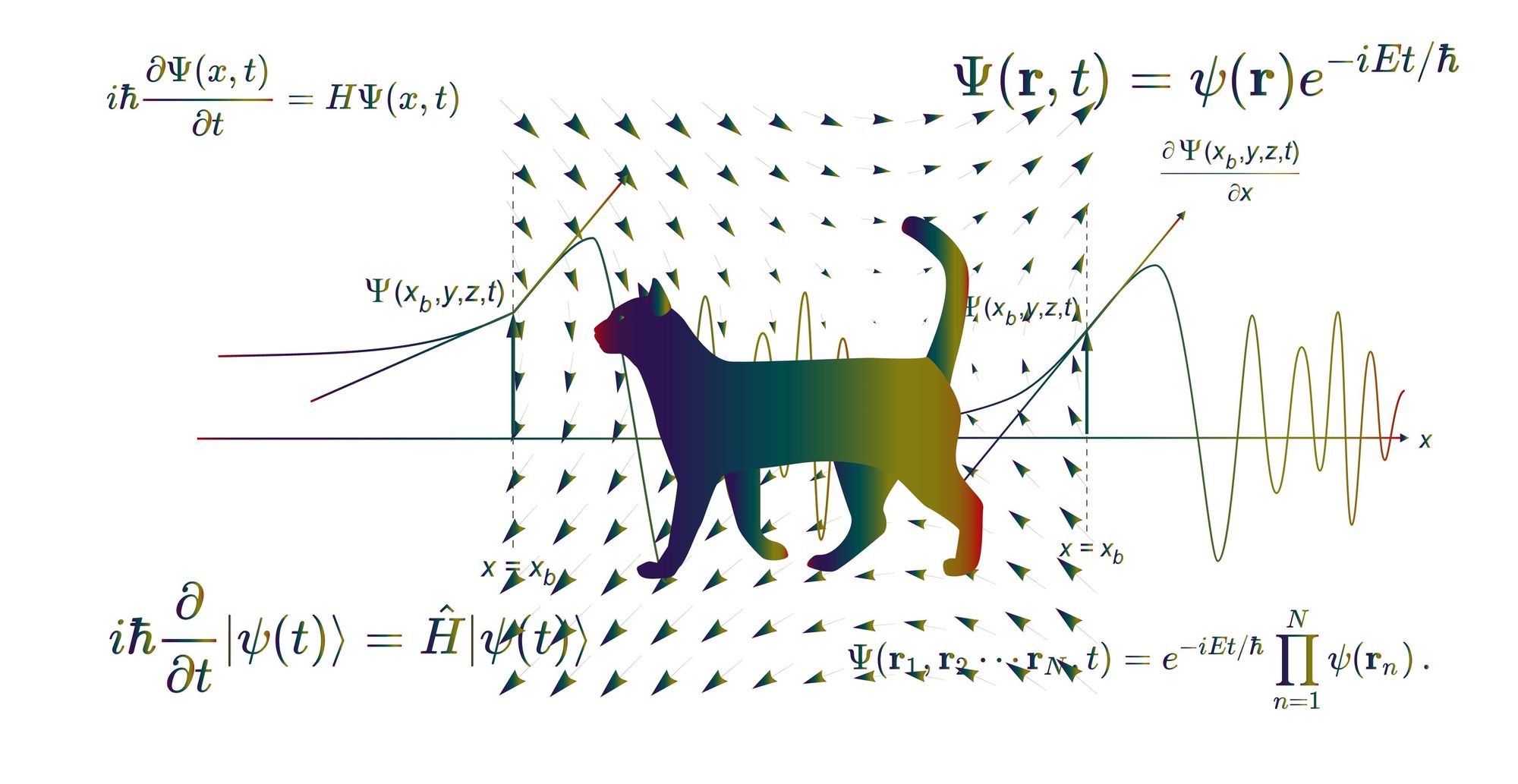

In the early 1900's scientific attention began to focus on "bizarre" properties of atoms and light at the smallest scales of physics. New experiments were producing results that could not be explained by Classical "Newtonian" Physics.
Cracks in the classical theory began to show as early as 1838, but by 1920 the debate had reached a fever pitch, leading to global conferences of the brightest minds.
Einstein, Bohr, Planck and others met several times over the 1910's and early 1920's in an attempt to mend the broken theories of physics. The result was a revolution in science known as Quantum Mechanics.

In the following decades, application of these Quantum Mechanic principles would yield powerful technologies, including LASERs, nuclear power, transistors, Magnetic Resonance Imaging (MRI) and digital electronic computers.
Unfortunately, this new field proved as dense at it was powerful. Even basic concepts of Quantum Mechanics are steeped in incomprehensible mathematics.
University physics classes and textbooks have only added to the complexity, jargon and circular references, leaving this realm of physics impenetrable to all except a very select few.
It's my opinion, that we have been teaching concepts completely backward.
My goal in this article: Deliver a clear and comprehensible model of how quantum reality actually works in approx. 15 minutes.
Classical vs. Multiverse
In the 5th century BC, a philosophy began to take root in China espousing a new view of reality.
The philosophy taught that each human decision causes the universe to fracture into two or more versions, one universe for each possible outcome. The countless human decisions each day throughout the world, create a limitless and growing number of universes. One world for each possible series of events.
However, an individual person doesn't experience these multiple realities. Their consciousness exists in only one version. At each decision, they are selecting a path and continue down only that branch of reality. The alternate paths become inaccessible.
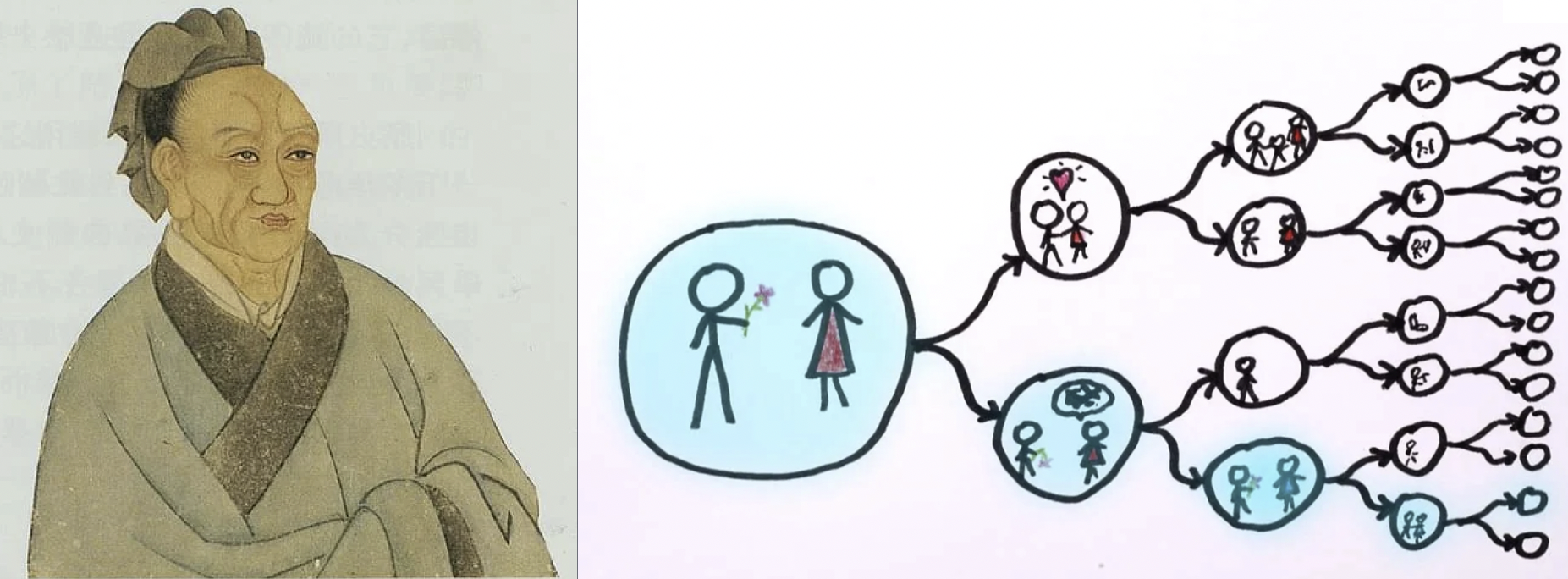
This branching cosmology is known as the Multiverse or Many Worlds interpretation of reality.
The multiverse model is in conflict with our Linear and Singular view reality known as the Classical Model.
It's easy to understand how a person living in such a branching multiverse would still perceive the world as singular and linear. We see only the version of reality that we experience.
How could we ever know if we are in a linear universe or a branching multiverse?
Scientists try to avoid hypotheses that cannot be tested or disproven which are said to be "Non-Falsifiable" and for most of human history there was no evidence to suggest we live in such a multiverse.
Birth of Quantum
Beginning in the early 1900's, experiments began to emerge which conflicted with the Classical model of reality, such as the famous Double-Slit experiment. As the body of scientific evidence grew, physicists began to consider the Multiverse model of reality as a serious contender for scientific explanation.
They postulated that the universe is constantly fracturing into many versions of itself. Unlike the Chinese philosophy, which believed human decisions to be the causal force of each split, this multiverse model predicted the fractures to be much more frequent (conservatively: +5,000 events per second). This multiverse interpretation of quantum physics predicts that every action of every atom or fundamental particle, which could happen in multiple ways, is enough to create new branches of existence (multiverses).
Understanding this new model of reality can be difficult. All our personal experiences and even our language are built on the classical linear understanding of reality. This is why discussion of multiverse experiments may seem bizarre or as Einstein called them 'Spooky'.
As we discuss this new physics and its implications, please remember that no matter how 'spooky' or strange it may seem, this is all 100% real and supported by over a century of laboratory experiments.
Superposition
Imagine flipping a coin into the air and snatching it mid-toss between your hands. Until you lift your hand to reveal the coin, you do not know if it landed heads up or tails up.
Despite the fact that you don't know it's state (Heads vs. Tails), the coin still exists in that reality. When your hand is lifted to reveal the coin, your knowledge about it's state changes, but the coin experiences no physical change. In other words, your ignorance or knowledge did not affect the coin. It was simply hidden.
In the world of the very small, reality works differently...
Fundamental building blocks of the universe, like electrons or photons, can also take one of several states like a coin (2 states) or a die (6 states). For example, an electron can be in a "spin-up" or "spin-down" state. A particle can also be sent into a random combination of it's states, much like flipping a coin.
But unlike a coin which will land and fully assume one of its states (heads/tails), the electron will become a superposition of both states (spin-up/spin-down) simultaneously.
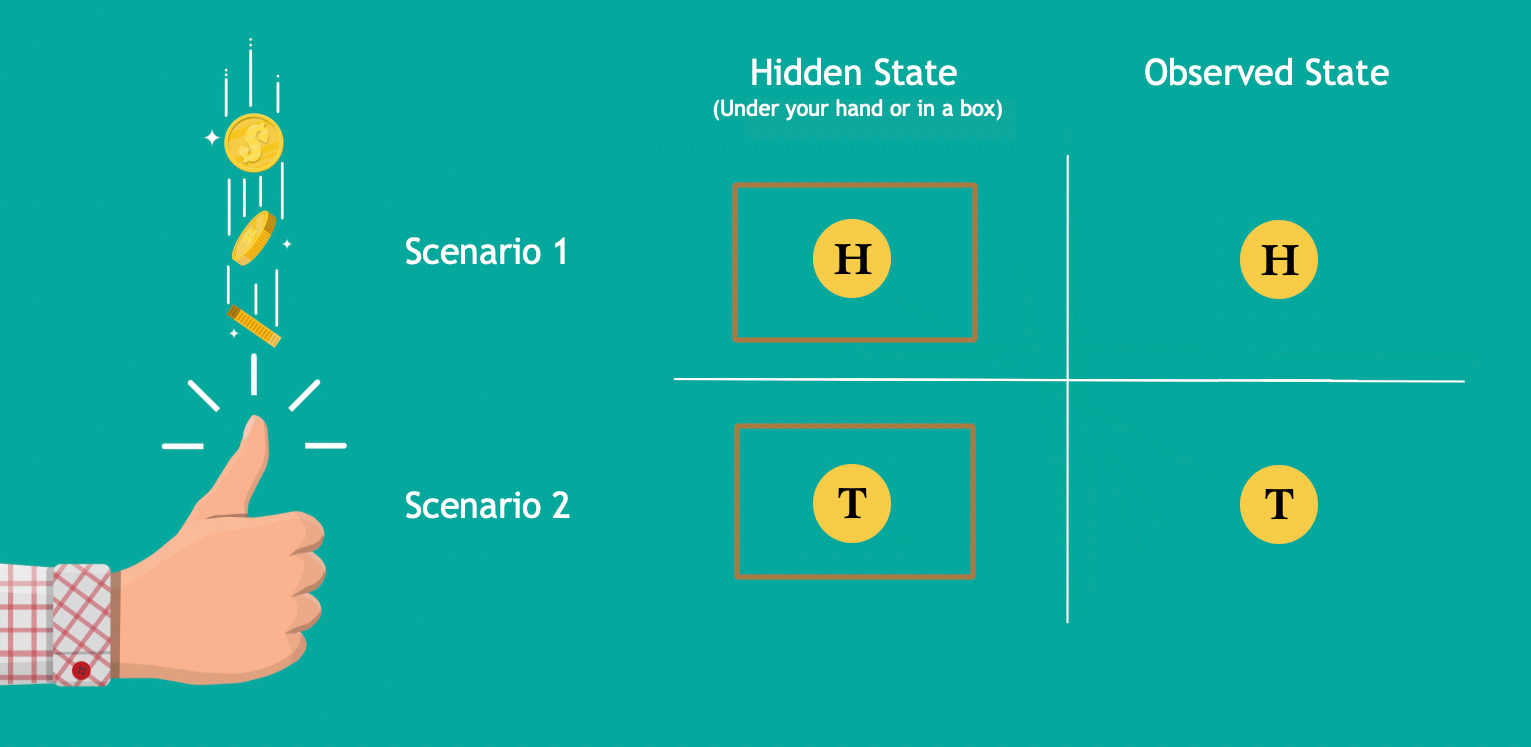
It is not simply a matter of ignorance where the electron is secretly in one of the states but you do know which state (like the coin example). Instead the electron is truly in both states simultaneously.
If you perform an experiment to observe the electron's state, then it will collapse to one of the states at moment of your observation.
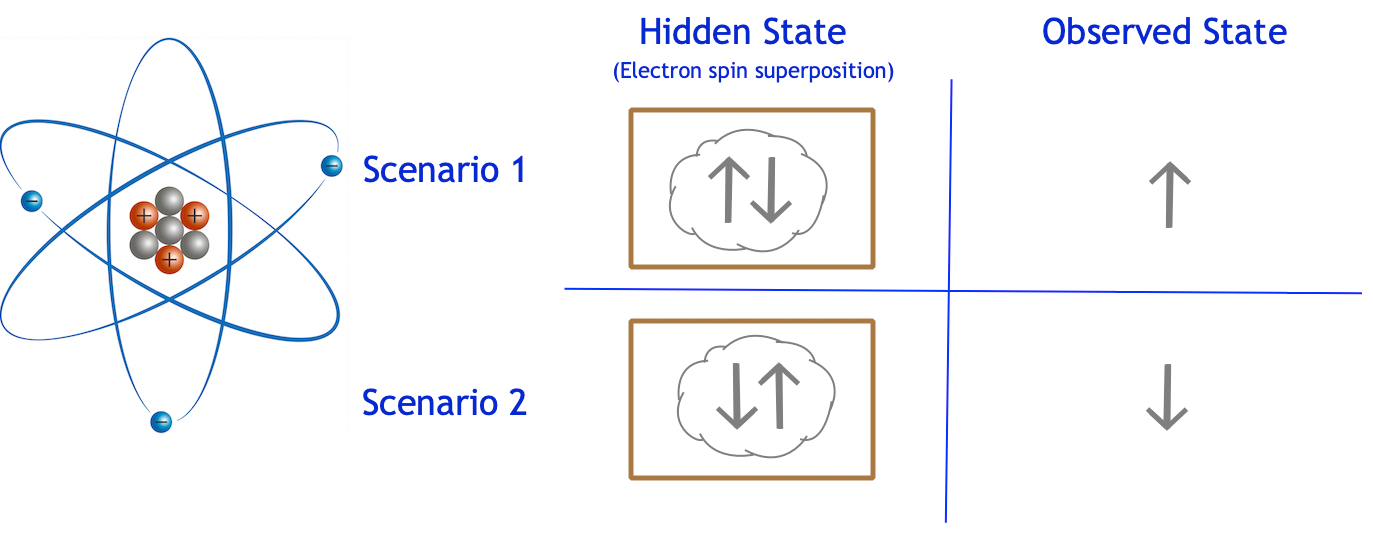
It is the act of observing the physical system which causes it to resolve to one reality.
Schrödinger's Cat
The most famous illustration of superposition is a thought experiment created by Erwin Schrödinger. It went something like this:
Build a sealed container which is insulated from the outside world.
Place inside this container:
One cat
Vial of poisonous gas
Radioactive atom with 50% probability of decay
Radiation-controlled hammer to break the vial
If the atom decays, it will cause the poison to be released, killing the cat.
Note: The key point of this experiment is to magnify a quantum event (radioactivity) up to the scale of the macro world (box, cat and gas) for easier discussion.

After the experiment is set up and time is allowed for the atom to decay, or not decay, there will be a 50% chance the cat is alive, correct? Schrödinger disagreed.
For an animated version of Schrödinger's Cat: Check out the first 1:15
He argued that instead of a 50% chance of the cat being alive (Classical physics), there is actually a 100% chance that the cat is in a superposition of being both alive and dead (Quantum physics).
The cat remains in this superposition until someone opens the box, collapsing the superposition of the cat. At that moment, the cat resolves (irreversibly) to being alive or dead.

Notice how this experiment (and the electron example) differ from flipping a coin. It is not merely a matter of ignorance about the cat's fate. It truly is both alive and dead.
Reversing Point-of-View
At this point, you must be getting a bit confused. Not only are these concepts bizarre, but the language used to describe is not ideal.
Confusing phrases like "the cat is in a superposition of both states until an observer collapses the wave function of..." are the norm in university physics courses.
This standard terminology leads to confusion for two reasons:
1. The linguistic phrasing is rooted in the linear (incorrect) model of time, causality and universe.
2. It is unclear what qualifies as an "observer" to collapse a superposition?
Does the observer have to be a human? What about an ant, or a camera? What about a piece of kibble which a living cat would eat, but a dead cat will not?
What exactly is enough of an observation to make the cat's superposition irreversibly collapse into being alive or dead? How long of a peek in the box?
Instead we should reverse the typical language of physics to create a simpler model of the multiverse.
At the moment of the radioactive decay, the cat and everything in the sealed box split into two universes. There is now one living cat and one dead cat which fully exist in parallel worlds. Each experiencing its own timeline and causality within the sealed box.
Everyone and everything outside the box does not split into separate realities, yet. Instead the outer world, including you, continues to "skate" along both universes in a superposition of both realities.
It turns out, it was not the cat that was in superposition. It was you!
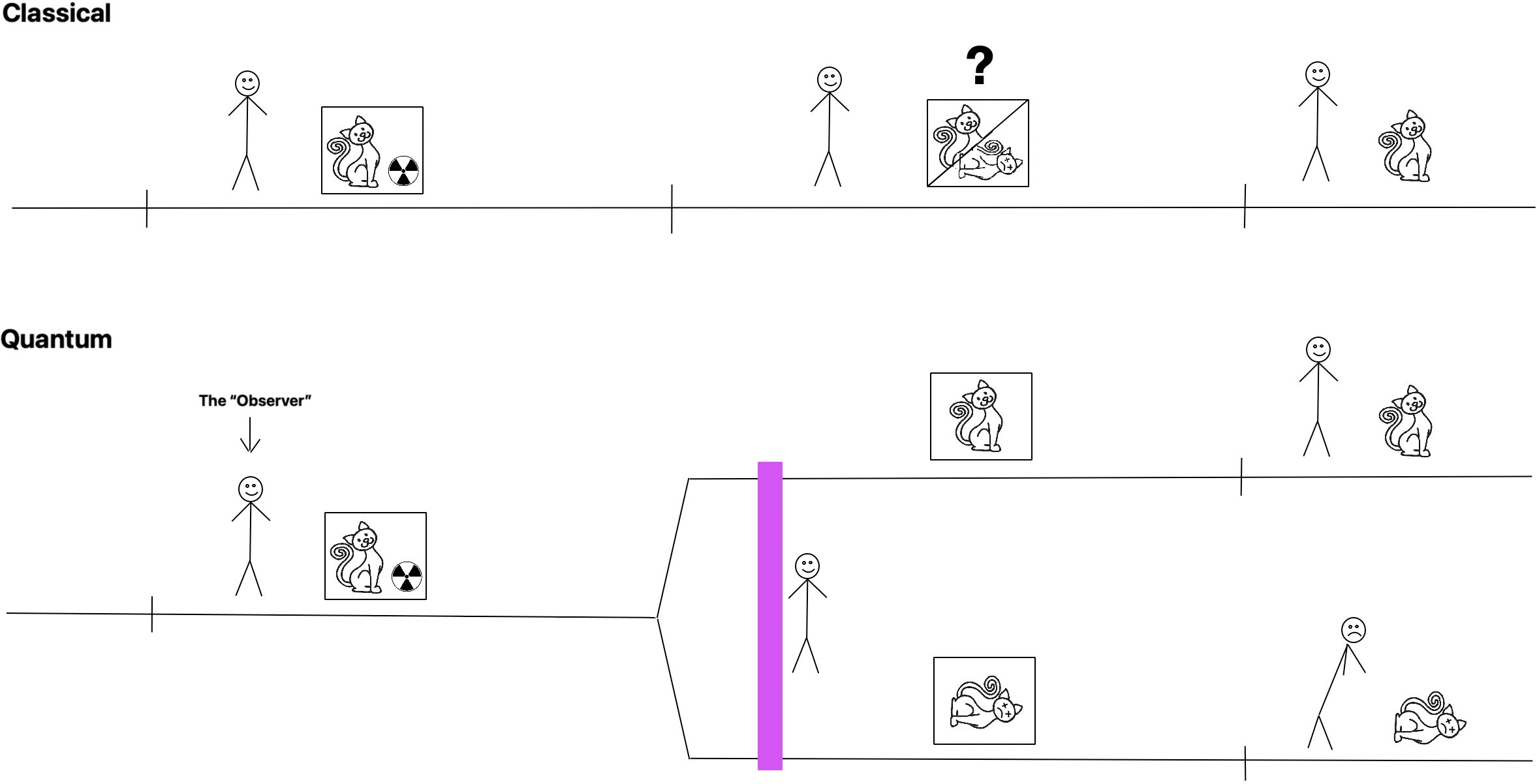
Multiverse Rails
For these illustrations, I will sometimes refer to the timelines of these parallel universes as "Rails" and the observer or environment outside the box as "Skating" along both of these rails simultaneously, without committing to either.
When the radioactive atom decays, the universe inside the box is split into two alternate timelines. Meanwhile the observer and everything outside the box remains in a superposition of both realities.
This is what I mean by reversing the terminology. It is more accurate to say that life inside the box is quite normal and linear, meanwhile it is the human, not the cat, that is in a superposition.
When the universe-splitting quantum event (radioactive decay) created two outcomes you were insulated from the event because the box was completely sealed.
As long as no information leaks out of the box (e.g. sound, smells, particles, or evidence of any kind), you will remain in a superposition of both universes.
Skating along the rails of two timelines...
The act of opening the box and observing the interior causes you to split into two versions of yourself.
Once information from within the box reaches your eyes, each version of you collapses irreversibly into one of the realities.
From your point-of-view (either version of you), nothing special happened. You still feel like you're living in a singular universe with a linear timeline. You cannot sense the split.
This model of quantum mechanics gives a clear explanation of superposition and the nature of an observer.
By reversing the frame of reference on who/what is in superposition, it becomes much easier to understand quantum superposition, especially in more complex experiments.
Schrödinger Squared
A slightly more complex example of Schrödinger's cat will clarify the concept of observer.
A Schrödinger box inside a Schrödinger box...
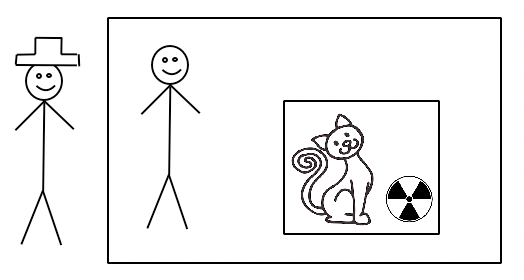
Repeat the steps of Experiment #1 with a sealed container, cat, poison etc. exactly as before.
Give the Schrödinger box to an experimenter Nick, placing him and the Schrödinger Box within an even larger sealed room.
Outside of the sealed room place a second experimenter Allison*.
Nick is insulated from the cat & poison. Allison is insulated from Nick, cat & poison.
*Allison has the cool cowboy hat
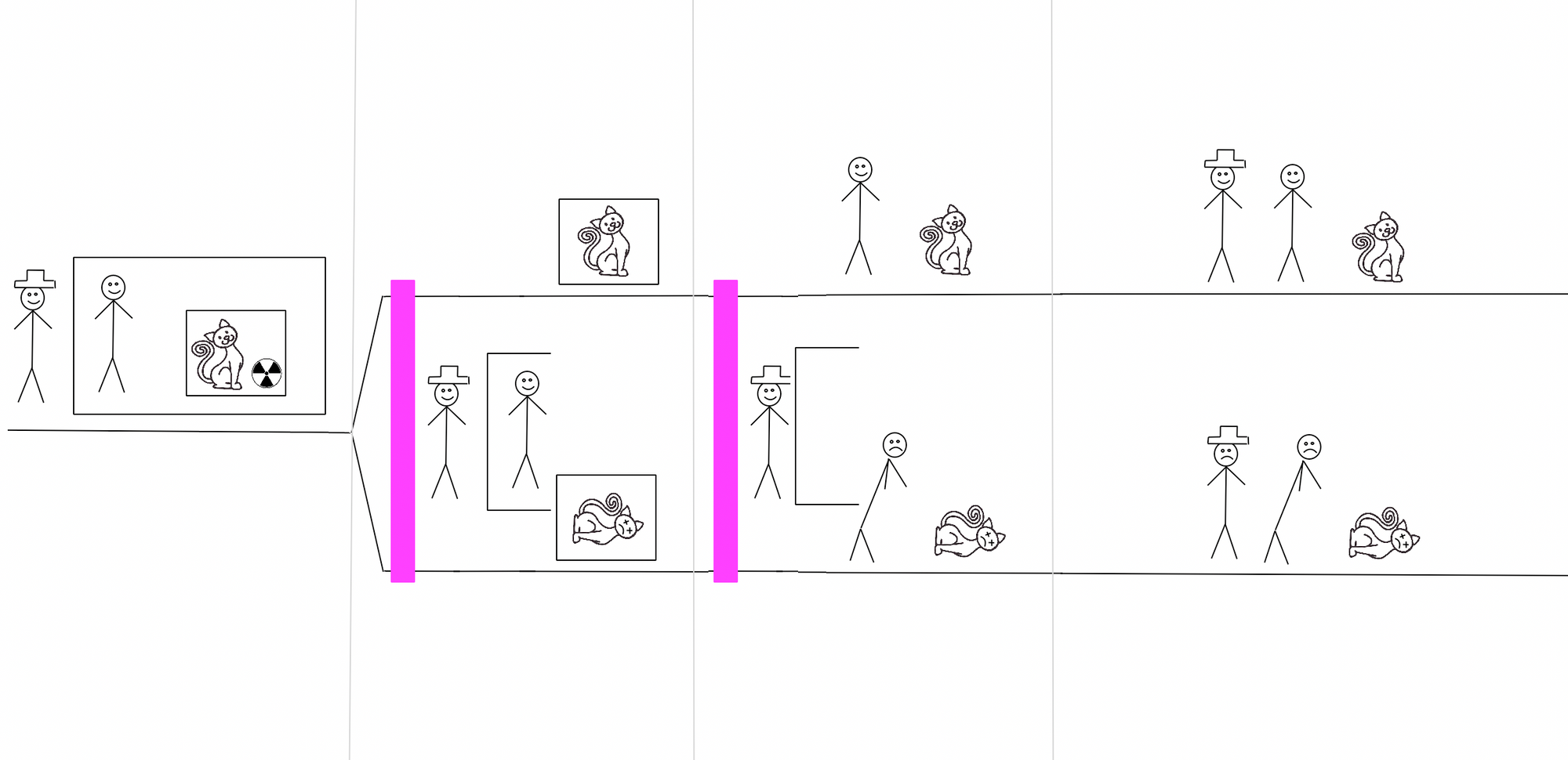
Event 1: Radioactive atom decays (or does not) with 50/50 probability, causing a split in the universe inside the smaller box. At this point both Nick and Allison are skating on both rails (on the pink bar). They are in a superposition of both timelines.
Event 2: Nick opens the Schrödinger Box. This causes him to split in two and collapse onto each timeline (rail). (His superposition collapses)
NOTE: Although one version of Nick is happy (living cat) and one version is sad (dead cat), Allison (outside the sealed room) is insulated from this information.
For Allison, the inside of the room is a superposition of both states of Nick and the Cat.

Event 3: Allison opens the door to the sealed room. This causes her (and the rest of the universe) to split in two and collapse onto the timelines.
This experiment shows how the outer world remains in superposition until information leaves the box and interacts with the outer environment, collapsing it from superposition into the two realities.
Or phrased in the traditional language of quantum mechanics: "the superposition is collapsed when an observer measures the system".
"The observer effect is the phenomenon in which the act of observation alters the behavior of the particles being observed. This effect is due to the wave-like nature of matter, which means that particles can exist in multiple states simultaneously. When an observer measures a particular property of a particle, they are effectively collapsing the wave-function of that particle, causing it to assume a definite state."
An observer can be anything which accepts information about the multiple states (rails).
Once the observer (any physical object or system)* undergoes a state change caused by information about the state of the split universes, it immediately collapses into the universes losing its special ability to ride both rails (superposition).
*A common misconception is that the observer must be conscious entity
Entanglement
Before entering, Allison doesn't know the exact state inside the room.
At that moment, it contains two universes with equal Probability Amplitudes (discussed later in detail). If she opens the door and collapses into the individual timelines, she could find a cat that is alive or dead, and a Nick that is happy or sad.
But she does know one thing for certain, the states of Nick and the cat will be "entangled". When Nick is happy it means the cat is alive. When the cat is dead, she can be certain that Nick is sad.
Knowing the state of one physical object, implies the state of the other object.
This is Quantum Entanglement.
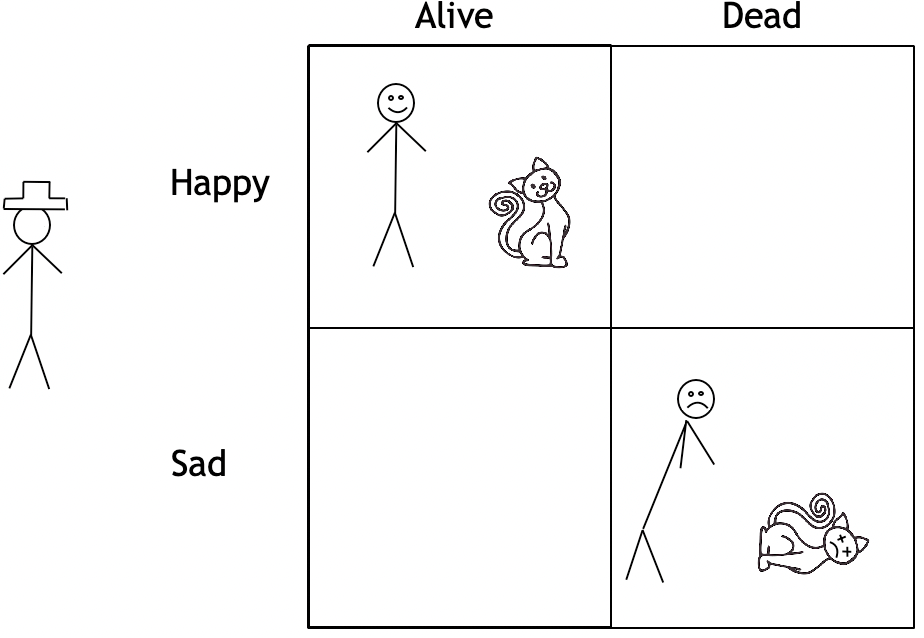
If this fact seems obvious from the previous examples, it is a testament to how much more clear this "reverse" model of understand quantum physics is than the traditional university approach.
Unlike cats, boxes and poison gas, a more common laboratory example of entanglement is paired particles with a net-spin of zero.
Two particles are prepared in such a way that each has a spin of "Up" or "Down". We don't know which spin each particle has without measuring (collapsing) it, but we do know that the particles have opposite spins. This is known because their spins sum to zero.
In other words, their spins are entangled because knowledge of one particle exactly implies the state of the other.
The particles are both in a superposition of spin up/down. But if you were to measure one particle, not only would it collapse but the other particle would instantaneously collapse despite not being measured...spooky.
This example, though smaller in scale, is exactly the same as the Nick/Cat entanglement and is used often in real world experiments (quantum computers).
Spooky Action
Entanglement is a popular topic in SciFi. For example, in the Three Body Problem trilogy, entangled particles are used in complex communication machines called "Sophons" to allow faster-than-light communication.
A 1-bit message could be sent, so the theory goes, by collapsing one particle stored in your transmitter causing the instantaneous collapse of it's partner particle stored lightyears away (in a receiver).
The possibility of such communication distressed Albert Einstein. He knew that a means to move information faster than lightspeed would violate several rules of physics and lead to logical paradoxes. But all the evidence from quantum experiments demonstrated that when one particle collapsed, its entangled counterparts would instantaneously collapse, even if they were a great distance away.
This lead Einstein to refer to entangled collapse as "Spooky action at a distance".
See also: Einstein-Podolsky-Rosen paradox
Utilizing entanglement for faster-than-light communication may be a common theme in Science Fiction, but it is just that, a fiction.
The act of observing one part of an entangled pair (or triple, or quad...) instantaneously collapses its counterparts only because its actually collapsing YOU onto a dedicated timeline. Your intended communicator would remain in a superposition whether you collapsed the system or not.
Only by telling the other person via conventional (light-speed) communications, would you infect them with your information of the particles and cause their collapse.

Repeat the steps of Experiment #2 with Allison outside of a (very long) sealed room, Nick and Schrödinger box are one her side.
After the radioactive atom decays and Nick opens the box, collapsing himself and entangling with the cat's state, the cat is moved by conveyer belt to the far end of the room.
The room is 1 light-hour long (about a trillion meters), so any information from one side should take an hour to reach the other end.
Another experimenter, Bob, is at the far side with his own door.
If either experimenter opens their door and collapses the superposition (collapses themselves), that will not affect the other experimenter.
For example, Bob opening the door would split his consciousness into two and collapse each half onto its own timeline with Nick & cat, but it would leave Allison in superposition of both.
If however Bob, learning the state of the cat, sent out a radio message toward Allison, her superposition would collapse when the message reached her and changed her physical state (knowledge).
Thus collapse is a personal event, which does not create communication any differently than conventional methods.
No faster-than-light magic...
Proof of the Multiverse
Now that we've covered Superposition, Entanglement and the role of an Observer, its time to address the question of how we actually know all this.
What proof is there of the multiverse, instead of the classical (linear) universe?
The next two experiments will cover evidence of the multiverse and how properties of multiple universes are harnessed in Quantum Computers.
The first experiment should feel very easy. It aligns with our classical view of the world.
Similar to experiment #2, Allison is outside of a sealed room.
The room contains Nick and two Schrödinger boxes, each controlled by an independent radioactive atom and vial of poison gas.
After the atoms are given an opportunity to decay, Nick opens both boxes simultaneously.
Later, Allison enters the room.

In this experiment, reality splits into four timelines instead of two: Two live cats, left cat alive, right cat alive, both dead.
When Allison opens the sealed room she will subjectively find each version with a 25% probability.
This should come as no surprise at all. It is the same as flipping two coins simultaneously and observing the probability of HH, HT, TH or TT (25% each).
In quantum experiments the "probability" of each timeline cannot be measured directly.
Once a superposition is collapsed, only one outcome is observed.
More precisely: The observer splits into multiple versions of themselves and collapse onto all the individual timelines, but afterward each observer only has a subjective memory of only one timeline (linear fallacy).
Instead, the concept of probability is defined similar to the classical version. If a coin is flipped 1,000 times and comes up Heads approximately 500 times, its probability is estimated to be 50%.
Likewise, probabilities in observation of quantum states is established by repeating an experiment many times and dividing the count of each outcome by the total runs of the experiment.
OR Gate
Now let's try an experiment that destroys some information before it leaves the box.
This setup is identical to #4: Allison, Sealed room, Nick, 2x Schrödinger boxes/cats except for one change.
This time the poison gas in the boxes is so powerful that when Nick simultaneously opens the boxes if either cat is dead, the fumes released will immediately kill Nick and the other cat: Total destruction.
The key of this experiment is to destroy any evidence of which (or both) cats had been killed initially.
In this way, it is a Quantum OR-Gate which creates total destruction if either/both atoms decay, but no destruction otherwise.

Since the three lower universes are now identical, it is mathematically equivalent to say that they are now one universe with 3x the Probability Amplitude.
Graphically I show this by recombining the universe's timelines into a rail that is 3x thicker.
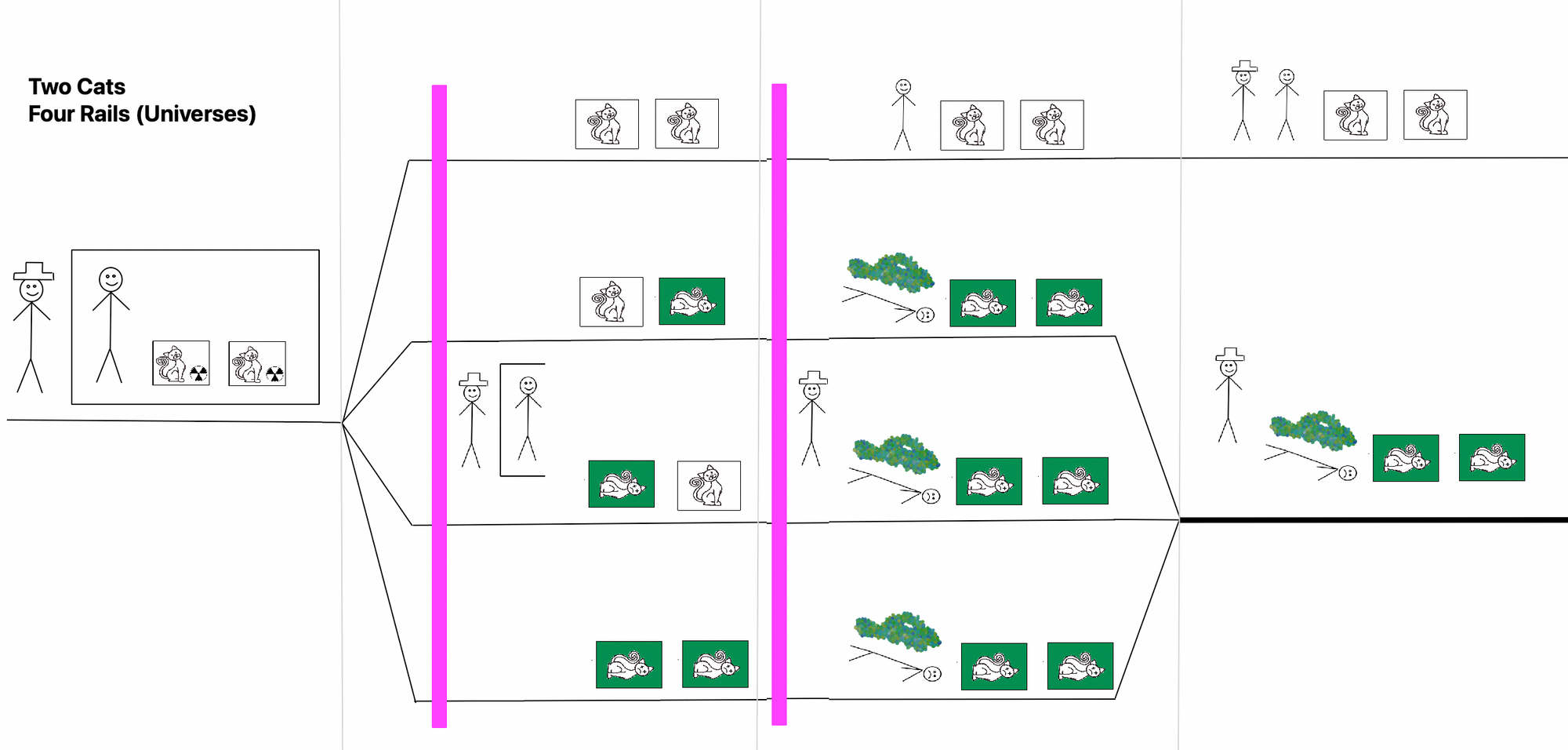
The Born Identity
The key question is "What will the probabilities be for these two outcomes?"
In the classical theory of physics it would be 25% and 75%. The three identical universes each have a probability of 25%, their combined probability is simply the sum.
In the quantum world, the truth is much more bizarre.
When quantum experiments were conducted in the early 1900's it was discovered that the probabilities were not 25%/75% but actually 10% and 90%!
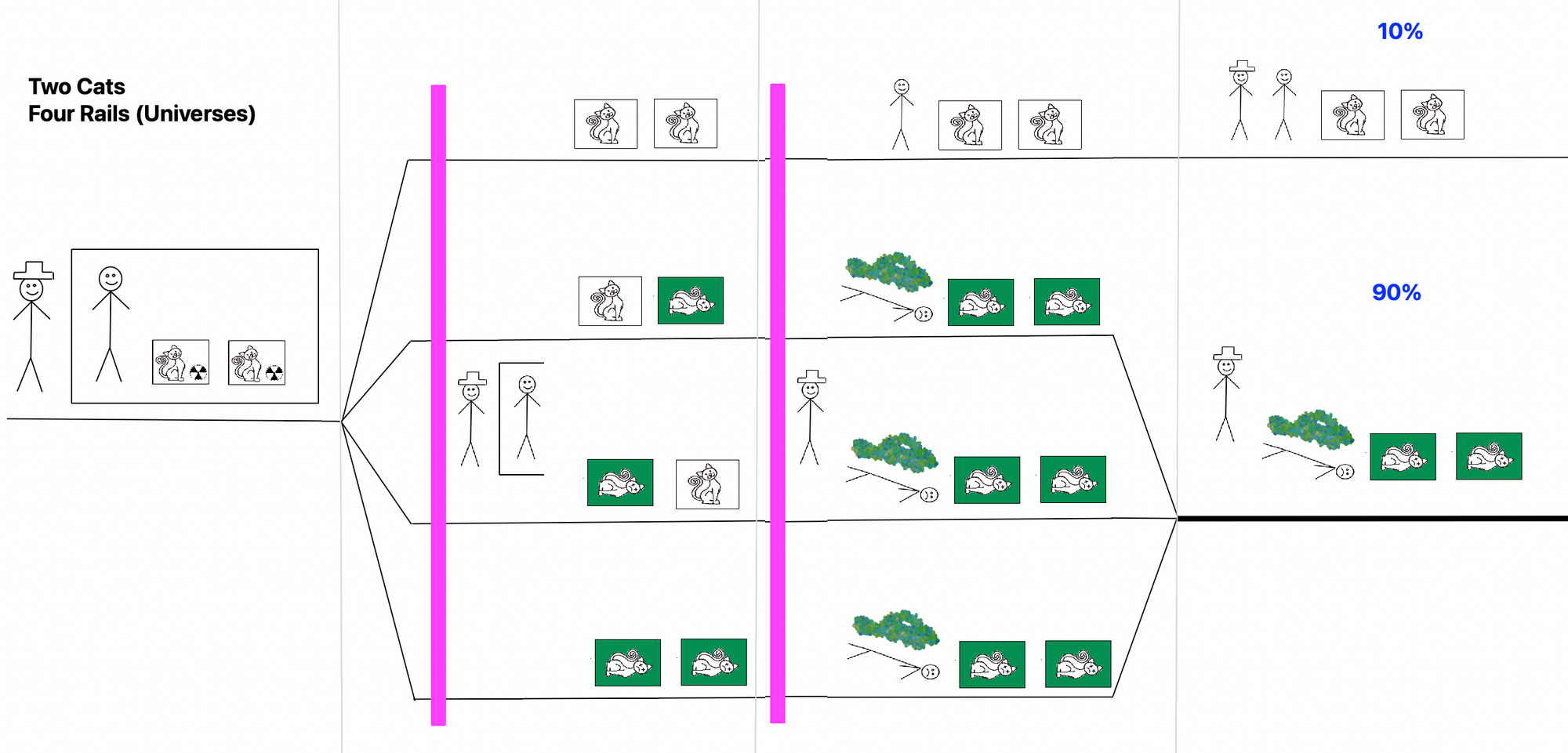
This outcome was truly unexpected and cannot be explained by any interpretation of classical physics. This is the basis of the multiverse.
Quantum probabilities are in proportion to the square of their amplitude.

Unlike classical systems where probabilities of different events are additive, quantum events first have their amplitudes added (like the 3 identical universes) then squared.
This rule is called the Born Rule after German physicist Max Born (not Jason Bourne).
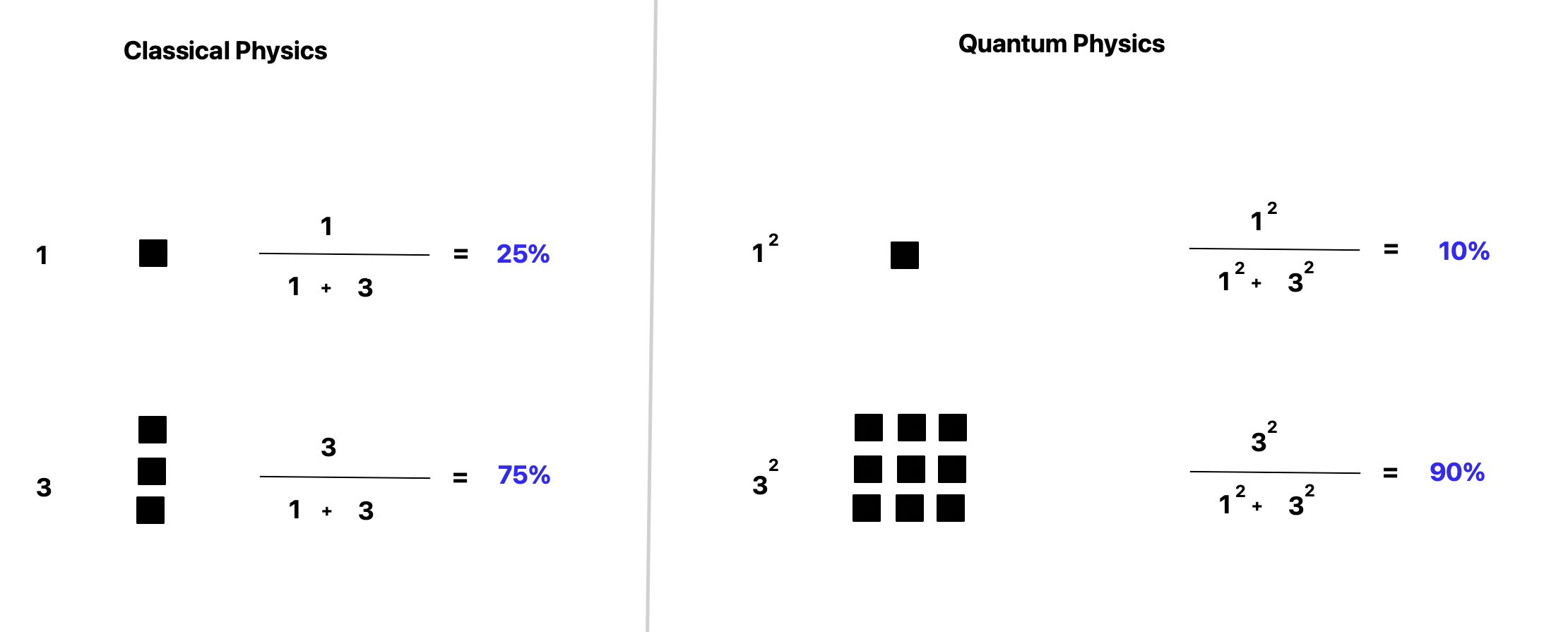
This mismatch between classical probability and quantum probability is known a Bell Inequality.
In a groundbreaking 1964 paper, John Stewart Bell showed that difference in expected probabilities could resolve the Einstein-Podolsky-Rosen paradox (EPR) mentioned above and disprove Einstein's "Hidden variables" conjecture.
By the 1970's multiple experiments in particle accelerators around the world had confirmed the Bell Inequalities and, by extension, the Multiverse Model of reality.
Then in 1985, the brilliant physicist David Deutsch wrote a paper describing how the intersection of quantum physics and classical probability could be used to created a class of computers trillions of trillions of times more powerful than any classical computer.
Quantum Computing: Recombining Universes
In the decade following David Deutsch's paper, computer scientists began to invent algorithms to run on these magical machines, despite the fact that no had built a working quantum computer.
By the 2000's, universities and private companies, like D-Wave Systems, were building functional quantum computers. Much like the example of the OR-gate experiment, the key to a functional quantum computer was to manipulate the many universes inside the box without any information leaking out.
By selectively splitting universes, combining a subset of them, via Quantum Logic Gates, and splitting subsets of those universes, the computers could perform meaningful calculations.
Of course the physical components in these mini sub-universes are atoms and elementary particles, not cats and Nicks.
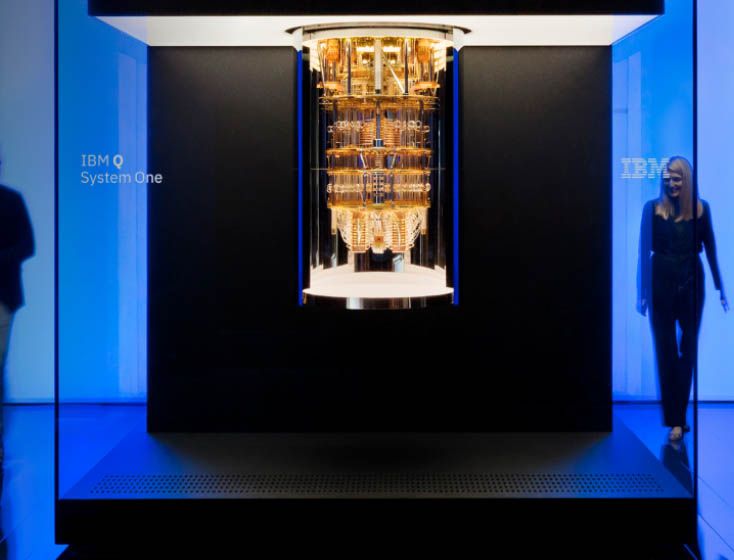
These subatomic particles store information, much like a classical computer storing bits as 1's and 0's. But unlike a classical bit which is exactly 1 or exactly 0, a quantum bit or "Qubit" can be in a superposition of both states at once.
To maintain quantum coherence in the particles, they are kept isolated and very cold, at nearly Absolute Zero. If a particle in a quantum superposition bumps into the surrounding environment (heat vibration) it will decohere (collapse the superposition of our surrounding universe by giving it information). This is equivalent to opening the Schrödinger box.
Quantum computers, like the one above, operate in bath of liquid helium at temperatures near zero degrees Kelvin.
The advantage of quantum computers is that they are actually just classical computers that exist across many parallel universes. They are the ultimate form of "Parallel Processing".
For example, if a quantum computer with N Qubits begins by setting all of them into superposition, this will split the universe into 2^N versions (every combination of 0 and 1 in N bits). Each version of the universe contains a computer with a different starting variable state. The computer can then run the qubits through quantum logic gates, executing an algorithm.
The superpower here is that the quantum computer can run every permutation of inputs in one calculation, whereas a classical computer would require 2^N cycles of the computation to achieve the same task.
This is particularly powerful for tasks like cracking encryption. A 2048-bit public/private key system could be cracked by attempting every possible divisor of the public semi-prime key.
It works because the quantum computer behaves like 2^2048 (32,317,000,000,000,000 + 600 more zeros) classical computers working in parallel across as many universes.
Quantum(); Return x
The REAL difficulty in quantum computers is extracting an answer. Any attempt to observe the physical qubits of the system causes them to collapse (you to collapse).
Each universe has its own outcome of the computation. When the circuit is finally observed, only one version will be seen (the universe that the subjective you, falls into). Therefore these algorithms (quantum circuits) must be designed in such a way that they converge toward one answer probabilistically.
In reality, the probabilistic aspect means that a circuit may need to be run a few times to establish part of an answer before proceeding, but this 10-20x slowdown is no obstacle for a machine that is 10^600 times faster for certain classes of problems.

Advantage: Check every possible permutation
Disadvantage: Return only 1 answer
The unique properties of quantum computers make them useful for problems that converge to one solution, particularly problems that are hard to solve but easy to verify. This includes cracking encryption and solving Sudoku puzzles. This class of problems is called "NP" of the famous "P=NP Complete" conjecture.
However for computations which require all of the answers be returned, like a GPU managing every pixel on your screen, quantum computers are no better than classical, just more expensive, complex and swimming in liquid helium.
Moore's Law of Moore's Law
Before concluding, I will make one final but important observation.
Moore's Law states that classical computers will double in power every two years. This law implies an exponential growth in the power of classical computers, which had held since 1965.
But if the power of a quantum computer is roughly = 2^Qubits, then to double the power of the machine, simply add 1 qubit. An increase of only 1 qubit effectively doubles the power of the machine.
So how fast are quantum computers growing in terms of qubits?
It turns out that the number of qubits is actually doubling at a regular rate. This implies an exponential exponential growth rate, a concept which is difficult to even imagine.
This "doubly exponential" growth is known as Rose's Law. For a more in-depth discussion of this topic, check out my article on the subject.
Conclusion & Links
Understanding quantum physics from the point-of-view of the multiverse offers a more clear model of concepts than the traditional method taught in most universities.
I hope that you have gained some understanding of Superposition, Entanglement and Quantum Computing.
To explore more deeply on this topic, here are some awesome resources.
Learn more about the brilliant and haunted man who first theorized the Quantum Multiverse, Hugh Everett.
The Many Worlds of Hugh Everett
For a wildly simple, but useful, dive into the workings of quantum computers, I recommend this short and cartoonish read by Terry Rudolph.
For a deeper dive into quantum topics, particularly the interaction of light and matter, check out Richard Feynman's QED. In just over 100 pages, he describes the most accurate physical theory in the history of science. It also won him the Nobel Prize.
To try your hand at designing and running a quantum circuit:
Need to make a tough decision? Want some help magnifying quantum events to the macro world?
Universe Splitter app connects to a laboratory in Geneva, Switzerland, which releases single photons into a partially-silvered mirror. Each photon will simultaneously bounce off the mirror and pass through it — but in separate universes.
Universe Splitter
For an industrial version of the app, consider purchasing a physical quantum device to attach to your computer. Quantis manufactures quantum generators of randomness (instead of cryptographic) which run in personal external hardware.
Quantis QRNG Devices
Equity trading with Quantum Time Circuits (QTCs)
While it is not possible communicate information faster than the speed of light, it is possible to use entangled particles to affect decisions past and future. To this end I wrote a quantum circuit which collapses a superposition, BUT ONLY if equity futures turn the opposite direction of a given trade.
The quantum computer and trading venue must be separated by far enough for the speed of light delay and trading dynamics to take affect (currently using NASA JPL quantum computer in Flintridge, CA and Chicago Mercantile Exchange S&P Futures).
This strategy is currently averaging 10-14% returns per week. Soon, I hope to achieve greater effect by distancing the two instances to Chicago and Sydney.
Below are my technical specs on the circuit and HFT system, along with C++ code.

